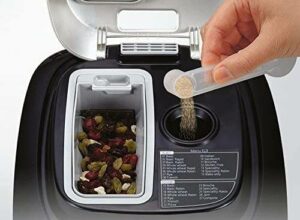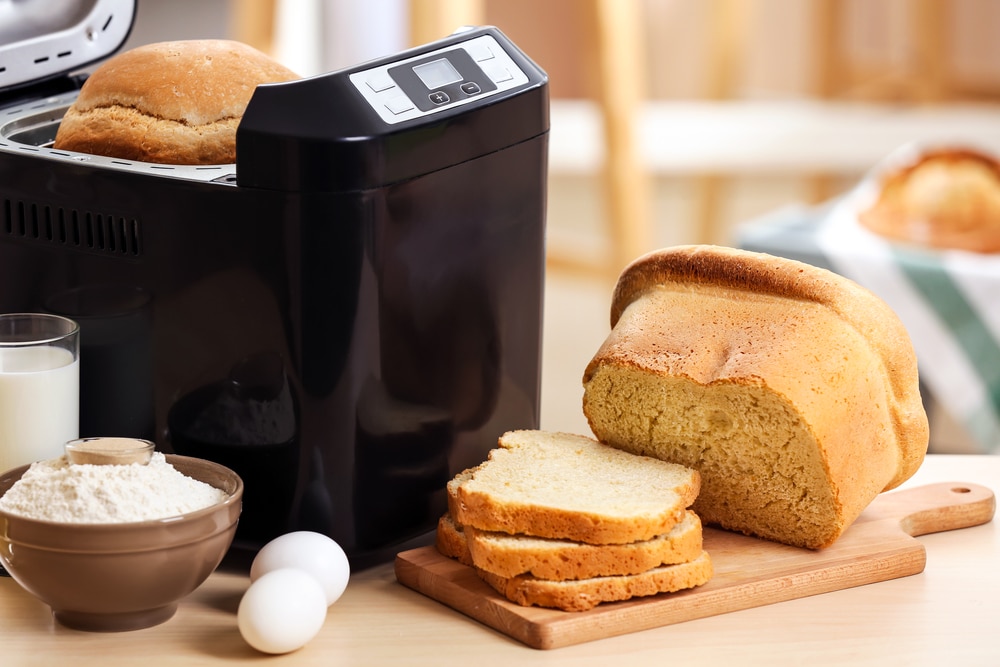Last Updated on January 10, 2023
Add your ingredients, press a few buttons, and like magic, your bread machine produces delicious homemade bread. At least, that’s how it seems. If you are wondering just how does a bread maker work, you’re in the right place. We’ll take a look at what goes on inside your bread machine, as well as how long they take, and what other items you can make in a bread machine.
Are Bread Makers Easy to Use?
Bread makers are very easy to use, so if you are worried about baking bread using a bread machine for the first time, don’t. While you’ll find it much easier to get great results using your bread machine than by baking bread by hand, there are some minor pitfalls that you should be aware of to ensure you get off to a good start with your new machine.
Remove the bread pan, measure out your ingredients, replace the bread pan, select your program, and hit start. It couldn’t really get any easier to bake homemade bread. However, as the saying goes, the devil is in the detail, so let’s go over some potential sticking points for first-time bread bakers.
View this post on Instagram
Ingredients
If you have ever made bread before, you will probably know that any problems with your bread are likely to be down to an issue with your ingredients – either quantity, temperature, type, or the ingredient order. This is why you should always start off by baking a simple standard loaf using the exact instructions from your bread machine’s accompanying bread recipes.
All ingredients should match those in your recipe. So, if your recipe calls for ingredients like strong flour, make sure you use strong flour. The rising and baking times will be set for strong flour mixes. This doesn’t mean that you can’t experiment with other recipes or create your own. However, when starting out with a new machine, it’s important to progress slowly and adapt as needed.
Similarly, make sure that you are using the yeast type that is recommended for your recipe, and don’t leave out or alter the quantities of any ingredients. For example, salt is required to slow down yeast activity. If you cut it out, your recipe won’t work as planned, resulting in more dense bread. If you put in too much, it could kill your yeast.
Baking is an exact science, so if you don’t want to use a certain ingredient, look for another recipe that will compensate for leaving out certain items.
Ingredient Order
 Another possible stumbling block to the best-baked bread is placing your ingredients inside your bread pan in the wrong order. Most manufacturers recommend placing your liquids in first, followed by your dry ingredients, then lastly, the yeast. This is because water activates your yeast. Some may also advise not placing your yeast directly on top of your salt, as while salt is essential for slowing yeast activity, too much can kill it. Hence, if you forget your salt, don’t sprinkle it on right over your yeast at the last minute.
Another possible stumbling block to the best-baked bread is placing your ingredients inside your bread pan in the wrong order. Most manufacturers recommend placing your liquids in first, followed by your dry ingredients, then lastly, the yeast. This is because water activates your yeast. Some may also advise not placing your yeast directly on top of your salt, as while salt is essential for slowing yeast activity, too much can kill it. Hence, if you forget your salt, don’t sprinkle it on right over your yeast at the last minute.
Ingredient Temperature
Yeast gets to work best in warm conditions. While your bread making ingredients should be able to come up to temperature on a standard loaf setting, it is recommended that you use warm water and room temperature ingredients. This is especially important for rapid cycles, where your dough may not have enough time to warm up sufficiently before and during the shorter rising interval.
While warm is good, hot is bad and could kill the yeast. A top tip for improving your bread’s structure and airiness is to use gently warmed filtered or bottled water. This ensures that you won’t be adding any chlorine from tap water to your dough which can also kill the yeast.
How Does It Make Bread?
An electric bread maker is basically a mixer and compact oven all-in-one. It mixes, kneads, proofs, and bakes your bread, taking care of the entire process from start to finish. Here’s a more detailed insight into how your bread making machines work.
Your bread machine comes with a bread pan, where your ingredients go and your loaf cooks. Inside your bread pan, there is a small kneading paddle that attaches to your bread machine’s axle. During the mixing and kneading stages, the kneading paddle turns to combine your ingredients into bread dough.
Once the paddle has finished its work and your dough has been mixed and kneaded, your bread machine will allow the yeast to get to work and your dough to rise. Once this stage is complete, the internal heating elements inside your breadmaker heat up to bake your loaf. Air vents are essential to allow your bread to rise correctly, as well as allowing steam to escape during the baking process.
Alternatively, many bread machines have a dough cycle function. This means you can use a bread machine to combine your ingredients for you so you can then remove the dough and bake it in the oven. You may choose to do this if you want to separate your dough to create more than one loaf, or perhaps you would like it in a different shape.
Your bread machine relies upon an electronic chip as well as stored system presets to achieve consistent results. All you need to do is simply select the program on the control panel for the recipe that you have chosen. If you are making large or small loaves, selecting the size will adjust the cooking time appropriately, as will selecting a lighter or darker crust setting.
How Long Does a Bread Machine Take?
 As your bread machine mixes, kneads, proofs, and bakes, the process takes several hours to make bread. If you need home-baked bread in a hurry, most bread makers have a rapid mode that usually takes less than an hour and a half for a standard loaf, or around one hour for a small loaf.
As your bread machine mixes, kneads, proofs, and bakes, the process takes several hours to make bread. If you need home-baked bread in a hurry, most bread makers have a rapid mode that usually takes less than an hour and a half for a standard loaf, or around one hour for a small loaf.
When using your bread maker’s rapid cycle, be sure to follow the included guidance about when to put the ingredients in. As your machine will only allow a limited time for your yeast to get to work when it is on a short cycle, many models will recommend using rapid-rise yeast. Rapid-rise yeast has smaller granules than your standard instant yeast, with a larger percentage of live cells, plus enzymes and other additives to ensure it gets to work extra fast.
Making bread with whole-grain flours or regular instant yeast can take several hours longer, with whole wheat flours needing a longer rise time than white varieties to ensure a great tasting, well-risen loaf. French bread making programs will also take a little longer than your standard basic loaf program. Most two-pound loaves will take between three to four hours to complete in your bread machine.
What Can I Make in a Bread Maker?
Aside from making bread, most good bread makers will also have additional programs to create other items. Let’s take a closer look at what different types of bread you can produce in your bread machine, as well as other kinds of food.
- Basic loaves – your bread maker will have a standard loaf of bread program for regular bread loaves made with white wheat flour.
- French bread – if you want fluffy white bread with a crispier crust, this program has a longer rising phase than the basic loaf program.
- Whole grain options – you’ll need to select the whole grain program to successfully bake whole-grain loaves with your bread machine. You can also make freshly baked whole wheat bread.
- Gluten-free bread – for gluten-free loaves your bread will rise only once and the cooking time will be adjusted to account for the higher moisture content.
- Dough – ideal for making pizza bases or any type of bread that you then finish off by hand shaping and baking in your oven. The dough setting includes the mixing, kneading and rising stages. From dough balls to braided bread rolls, the ‘dough’ program is a great option.
- Cake/banana bread – if your bread maker has a cake program, or simply a bake button, you can use it to bake cakes.
- Jam – if you want to make something different, use the jam program for delicious homemade jams without any hassle of having to stand over a simmering pan. Your bread machine cooks your jam while simultaneously mixing for perfect results.
- yoghurt – follow your manufacturer’s instructions and use the recommended quantities to make your own delicious yoghurt in your bread machine. It’s another great way to take control of what you eat, without having to spend hours in the kitchen.
- Rice dishes – if you don’t have space for several kitchen appliances, you can even use bread making machines to cook rice. It also can make superb rice pudding and risotto. Just use the jam function and your bread machine will cook your rice while stirring.
View this post on Instagram
Conclusion
At the beginning of this article, you asked: “how does a bread maker work?” We hope we have answered this question for you and given you the information you need to get started.
While making bread at home by hand kneading is a long and often arduous process, using a bread machine couldn’t really be any simpler. Once you have chosen your recipe and measured out your ingredients, all you have to do is hit a few buttons, press start and wait to enjoy your freshly-baked homemade bread.
Whether you want to cut out additives and preservatives, bake gluten-free, or just can’t get enough of the taste and texture of fresh, warm bread – bread machines make home baking exceptionally easy, with consistent and delicious results every time.
Kelly is an expert in consumer product research, which is very important when it comes to finding the most useful and aesthetically pleasing items for your home. This became her passion after finding it very time-consuming to wade through all the product information online.
She has a keen attention to detail which she brings to her articles, Kelly’s goal is to help you find what you need without spending too much time searching for it.

